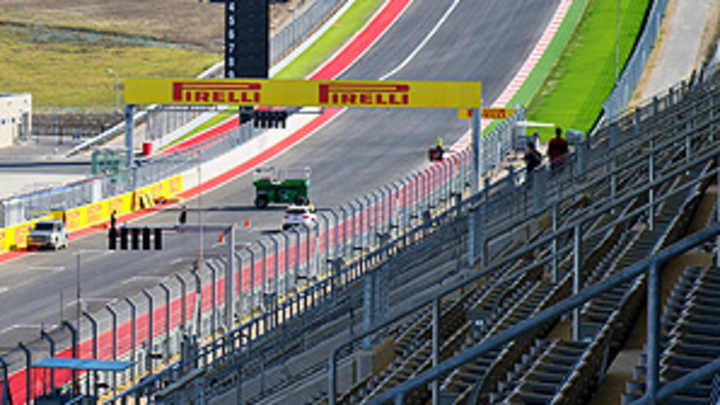Formula One hoping to catch American attention with new track


AUSTIN, Texas (AP) -- Formula One, the world's most popular motorsport, is trying once again to conquer its final frontier: the United States. This time, the Europeans aim to make it stick.
The glitzy sport with ultra-fast cars and a flair for the exotic has landed deep in the heart of Texas, of all places, with a gleaming new track, a down-to-the-wire championship race and hope that it can grab the attention of American race fans who rarely look up from the NASCAR standings.
The U.S. Grand Prix makes its grand return after a five-year absence on Sunday at the $400 million Circuit of the Americas, a course built expressly for F1 on rolling scrub land just a few miles southeast of downtown Austin.
"This is what was needed," said Mario Andretti, the Formula One champion in 1978. "Now we can compete with the rest of the world and some of those new venues that have gone up in the last few years in the Middle East and Asia. That's the ingredient that was missing here in the United States."
Austin is the 10th American city to host F1 since the first U.S. Grand Prix in Sebring, Fla., in 1959. Watkins Glen, N.Y., hosted a Grand Prix from 1961-80 and other F1 races have been held in Long Beach, Las Vegas, Detroit, Dallas, Phoenix and other cities on street courses.
As NASCAR grew into the dominant motorsport in the U.S., demand and interest for open-wheel racing took a hit and F1 didn't even race in the U.S. from 1992-1999 before making its return at Indianapolis Motor Speedway, the cradle of American racing. Even there, it couldn't last and track officials and Formula 1 boss Bernie Ecclestone parted ways.
Formula One stuck to its global circuit and had seemingly abandoned U.S. until Ecclestone made the surprise announcement in May 2010 that it would return with a 10-year deal to race at a track that hadn't even been built yet. With billionaire businessman Red McCombs one of the key investors in the project, organizers began a mad dash to build the track.
Austin seemed an odd choice. A trendy city of about 1.5 million, Austin bills itself as the "Live Music Capital of the World" and is the capital of Texas. But it hardly fits in with the other cosmopolitan F1 hosts like Melbourne, Shanghai or Singapore. Earlier this month, Austin Mayor Lee Leffingwell joked that Austin hosting F1 was "sort of like Mayberry having the Super Bowl."
The U.S. Grand Prix achieved its mandatory goal of getting the track built, but the challenge will be how to succeed and keep drawing fans beyond the initial excitement of the inaugural race.
"It looks like they have got a beautiful circuit down there. The challenge is going to be maintaining that in year two, three that kind of thing, because that's where Formula One in the States has struggled," said Eddie Gossage, president of Texas Motor Speedway, which hosts NASCAR and IndyCar races about three hours north of Austin. "They had great crowds in Indianapolis, for instance, to start with and just couldn't sustain that."
Bruton Smith, chairman of Speedway Motorsports Inc. which owns and operates eight tracks, was dismissive of Formula One's future in the U.S. and the possibility of it picking off fans from NASCAR. There's already head-to-head competition. The NASCAR season finale in Homestead, Fla., is on the same day the U.S. Grand Prix makes its debut.
"Formula One has never been anything in this country. Go back and check it. Go back as far as you want to and Formula One has never worked in this country," Smith said. "We've checked and about 10 people that we know are going to it, so we're not really concerned."
Zak Brown, chief executive and founder of the Just Marketing International firm that caters to auto racing, sees a different scenario. The return of F1 to the U.S. at the Circuit of the Americas is the footprint the sport needs in the American landscape.
"It's massively important," Brown said. "North America has been the one market where they've really struggled."
Brown noted Formula One recently signed a new, four-year broadcast deal with NBC Sports Group. The exclusive rights deal, which begins next season, will provide more than 100 hours of programming across NBC and cable channel NBC Sports Network.
"You need a great home base, they have that. You need a good TV package, they've got an enhanced TV package," Brown said. "Ideally, all they need now is an American driver."
That hasn't happened yet. This season's championship chase is down to two drivers, Red Bull's Sebastian Vettel and Ferrari's Fernando Alonso, who are separated by 10 points with two races left.
Andretti said he hopes F1's return to the U.S. will nurture a homegrown driver of the future.
"I always say F1 is like the Olympics. There's a lot of national pride and to have an American representing his country would be fabulous," Andretti said.
Several F1 drivers said this week they are excited about the return the U.S.
Kimi Raikkonen of Lotus, who won the 2007 Formula One championship and sits a distant third in the current standings, raced seven U.S. Grand Prix at Indianapolis and drove twice in NASCAR Trucks and Nationwide events in 2011.
"I like the American atmosphere. It's just a relaxed environment, they know how to have fun, and most of all, they love racing," Raikkonen said. "After seeing the excitement of the American NASCAR fans, I hope Formula One gets people as eager to enjoy our racing in Texas, too."
